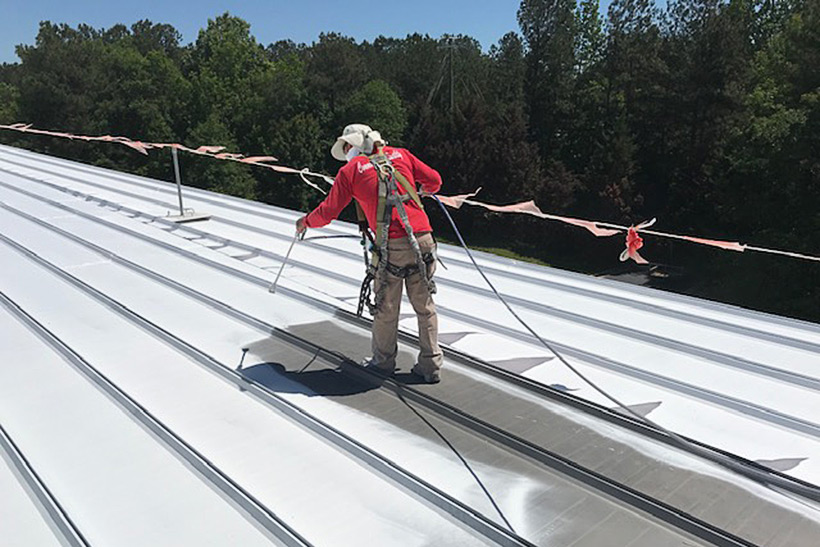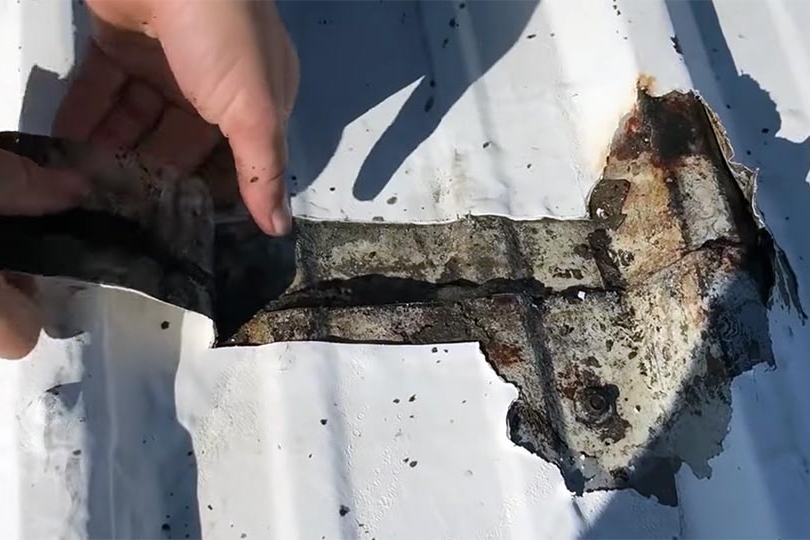
Few roofing materials match the strength, performance, and longevity of metal roofing. Despite this, metal roof leaks still occur. The key to maximizing a metal roof’s lifespan is understanding what causes them to leak. Below, we address five common causes of metal roof leaks—even with correct installation—and how to repair them.
Attention! If you have a metal roof leak needing repair, click here to schedule a free evaluation with an American WeatherStar Approved Contractor.
5 Common Causes of Metal Roof Leaks
1. Metal Roofing Screws
Roofing screws cause the majority of metal roof leaks. By squeezing a rubber washer at the screw’s base, metal roofing screws keep water out. When inserted into the panel, the rubber washer creates a “gasket” between the screw head and the metal roofing panel.
While it seems easy, mistakes can be made, including underdriving screws, overdriving screws, driving screws at an incorrect angle, and screws that miss the frame component entirely.

Over-driven screws
The screw can be overdriven into the metal roofing panel to ensure that the tight seal between the screw head and the panel has been met. This may damage the roofing panel, which poses other issues that must be resolved. The additional tension usually causes the rubber washer to break and spin to the side, disrupting the sealing required to stop the water from dripping into the hole.
Under-driven screws
Screws can be under-driven if the screw is not torqued tightly enough as it enters the metal roof. The rubber washer’s improper seating against the metal roofing panel resulted in the leak. When this occurs, neither a gasket seal nor the rubber portion of the screw is ever compressed.
Screws driven at the wrong angle
Getting that seal is essential for a successful screwing of the metal screw. When you screw in at an incorrect angle, the rubber washer has nowhere to rest flat. As a result, the seal won’t work correctly, and metal roof leaks will continue to occur nearby.
Missed metal strut or wood framing below
When this occurs, the screw has nothing to seal against, making leaks challenging to locate even if the screw is present.
Wear and Tear
Even correctly-driven screws tend to back out over time. The gaskets dry out and weaken over time. This, too, can cause the metal roof to leak around the screws.
2. Stack Flashings
When pipes or vents protrude from a metal roof, so-called “boots” or flashings are placed there. They are typically constructed of rubberized material and used to seal around pipes and air vents.
These are some places where a metal roof is most likely to leak, partly because stack flashings only last about half as long as the actual roofing material. Heat-induced expansion and contraction of metal roofs put stack flashings under a lot of stress over time. Once they break, the best course of action is to have a certified roofing professional replace the stack flashings.
3. Missing Sealants
During the installation of a metal roof, sealants are used to waterproof parts of the roofing assembly. These sealants are typically less durable than metal roofing panels. They must be updated as part of routine roof maintenance, especially in these areas:
- Metal Ridge Caps – The trim attached to the roof's ridge, or the peak where two roof slopes converge, is known as a metal roofing ridge cap. Typically, a ridge cap is only placed after the metal roof panels and associated trim has been identified.
- Z-flashings – These are utilized to stop water from penetrating the horizontal connections between siding sheets. The metal's huge leg rests against the wall, leaving the seat and face to cover the siding's upper border.
- Roof Transitions – The transition flashing stops leaks at the junction of two distinct roof pitches. It can be sealed under the top panels with inside closures, while the lower side must be sealed with outside closures.
- Counter flashings – Forming metal or elastomeric sheeting that is fastened to or integrated into a wall, curb, pipe, rooftop unit, or other surfaces to cover and safeguard a base flashing's top edge and any accompanying fasteners.
- Reglets – This is positioned between a roof and a wall (or the rear of a parapet wall). This flashing is used in conjunction with counter flashings to prevent leaks in a roof's 90-degree edge, one of the essential parts of the structure.
- Pitch pans – A metal container with an open bottom and flanges called a pitch pan is used to cover roof penetrations. Mastic material is then used to fill them, creating a watertight seal. A pitch pan is, in other words, a kit for installing a new roof flashing.
4. Curb Flashings
Installing HVAC systems on a metal roof is quite common. Most frequently, the HVAC will be mounted on top of a roof curb, a metal construction intended to hold the unit’s weight and provide a way to link the ducting.
One of the most typical areas for leaks to develop on metal roofs is the region around a roof curb. Even if flashing is properly put around the curb, water can eventually seep through, especially on the curb’s upward-facing side.
5. Seams & Overlaps
A metal roof will unavoidably have gaps and areas where panels overlap. When your roof is installed initially, these areas must be adequately sealed because they will eventually cause metal roof leaks.
They frequently leak due to a condition known as a capillary draw. Water moves in the tiny gaps (capillaries) between the steel roof sheets where they meet, causing capillary action. A capillary draw is another term for capillary action. When the roof is built initially, rubber or mastic seals are put on either side of the fasteners in between the roof sheets.
These seals will deteriorate over time. This is a result of the roof system’s ongoing movement, brought on by adverse weather conditions, including wind, heat, the weight of water, or snow accumulation. Water will flow in any direction and even resist gravity in small crevices, like the area between steel roof panels. Surface tension, cohesion, and adhesion forces are to blame for this.
How to Repair Metal Roof Leaks
Roof Sealant
Roof sealants have two essential functions: fixing your roof quickly and protecting it short-term. Depending on the product, roofing sealants can produce a seal against moisture and ultraviolet radiation. Additionally, they can fix minor leaks before they cause costly rot and mildew damage.
American WeatherStar offers Terminator Roof Sealant, a 100% solids moisture-cure product specifically formulated to perform in extreme weather conditions. It is our best sealant for metal roof leaks. Click here to learn more.
Remove/Replace Screws
As previously discussed, water entry points into the structure can be created by screws that are either over-driven, under-driven, pushed at an angle, or entirely miss the metal strut. Due to old age, the screws can also back out or have failing gaskets.
The screws and fasteners would need to be removed and replaced, but it’s crucial to understand that this is a very labor-intensive repair option and might not be ideal.
Roof Coating (Roof Restoration)
With commercial roof coating systems, building owners can keep their existing roof—no tear-off is involved. A fluid-applied coating system, which costs significantly less than a total replacement, is intended to extend the lifespan of an existing roof.
A fluid-applied commercial roof restoration system can last 10–20 years, depending on the type and mil thickness of the system.
Recommended Reading: Which Roof Coating Performs Best?
SPF (Spray Foam Roofing)
Spray polyurethane foam may be installed over your current metal roof as a fantastic alternative. Since it offers additional advantages that coating methods don’t, it may be put over your existing roof with less tear-off.
Recommended Reading: Spray Foam Roofing: The Complete Guide
Roof Replacement
If your metal roof is more than a decade old or has significant damage, it is time to consider replacing it. Here are a few indicators that it’s time to replace your metal roof rather than fix it if you need help determining which way to turn.
- Extensive Rust – Rust is a symptom that your roofing system's metal and protective coating system is aging. Water and moisture will start damaging the metal once the coating and finish are lost, and you will soon have leaks.
- Loose Panels – In many cases, loose panels may be fixed. However, if you have a large number of them and they have all been ignored, you likely have underlying damage that has to be repaired, which will ultimately result in replacing your roof.
- Widespread Leaking – Rust, loose panels, missing fasteners, or poor installation can all result in leaks.
Conclusion
You should find out more now that you know the various possibilities on how to repair a metal roof leak. We’ve listed our top resources below:
If you’re interested in scheduling a free roof inspection, contact an American WeatherStar Approved Contractor today.
Related Posts
Met-A-Gard System on a Leaking Metal Roof
A large manufacturing company in the Atlanta area was having leaking issues in their metal roof for several years. In this scenario, an American…
Metal Roof Rust Damage
In this Tech Talk, Brian and Merv inspect a horizontal seam on a previously-coated metal roof with rust damage. The seams on this roof were…
Measuring Metal Roof Profiles to Determine Stretch Factor
In this edition of Tech Talk, Eric demonstrates how to determine stretch factor on a metal roof. Stretch factor has to be taken into…












